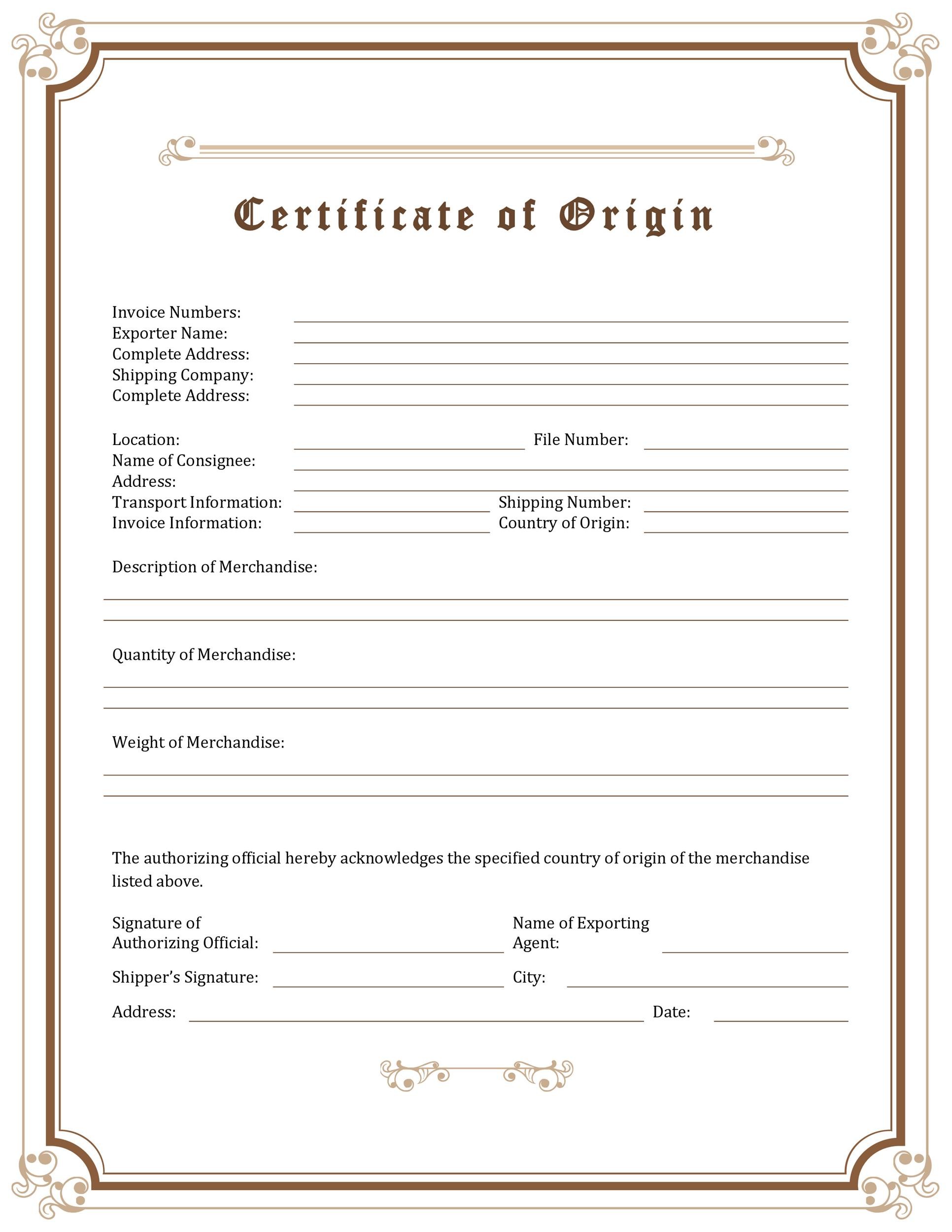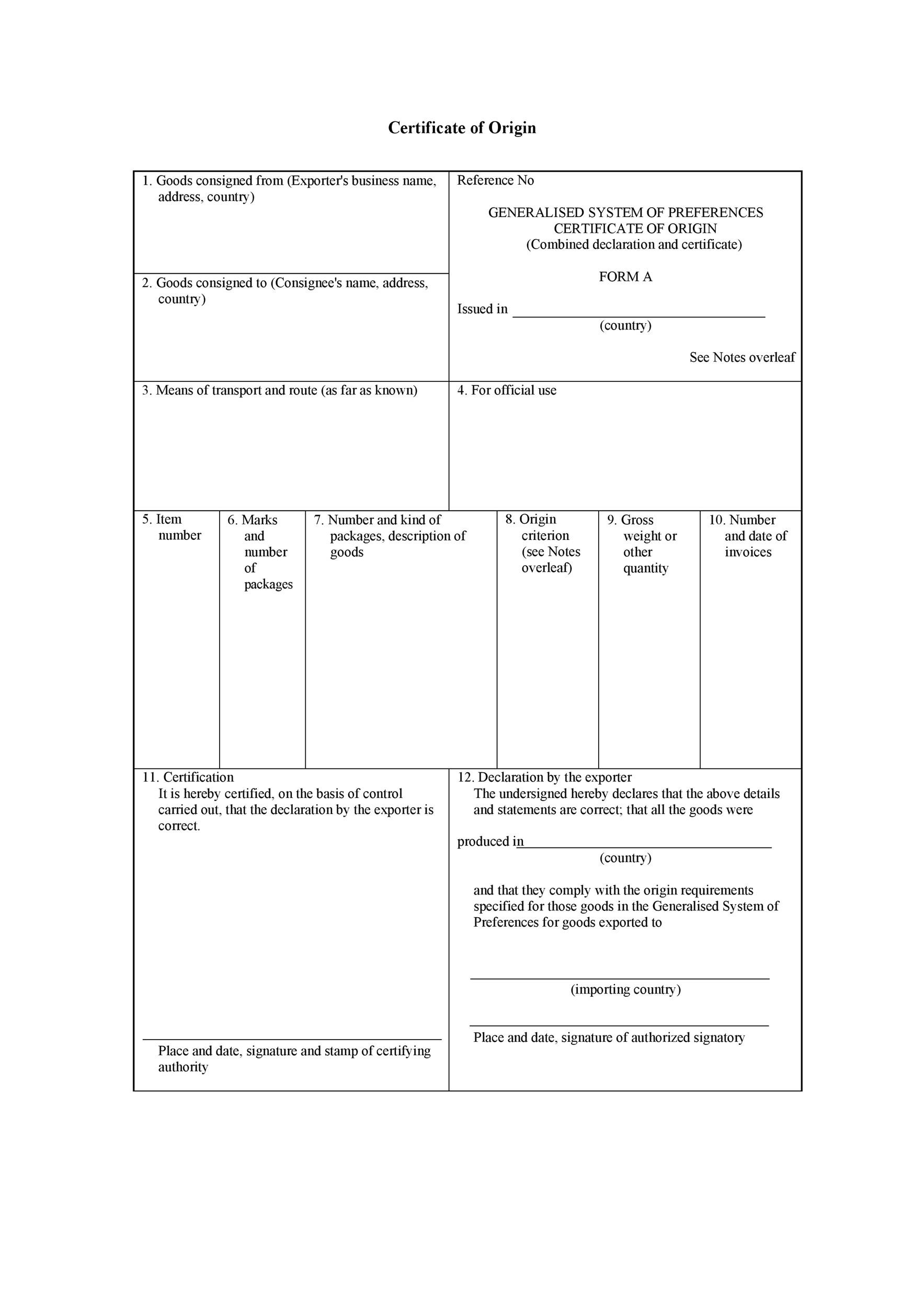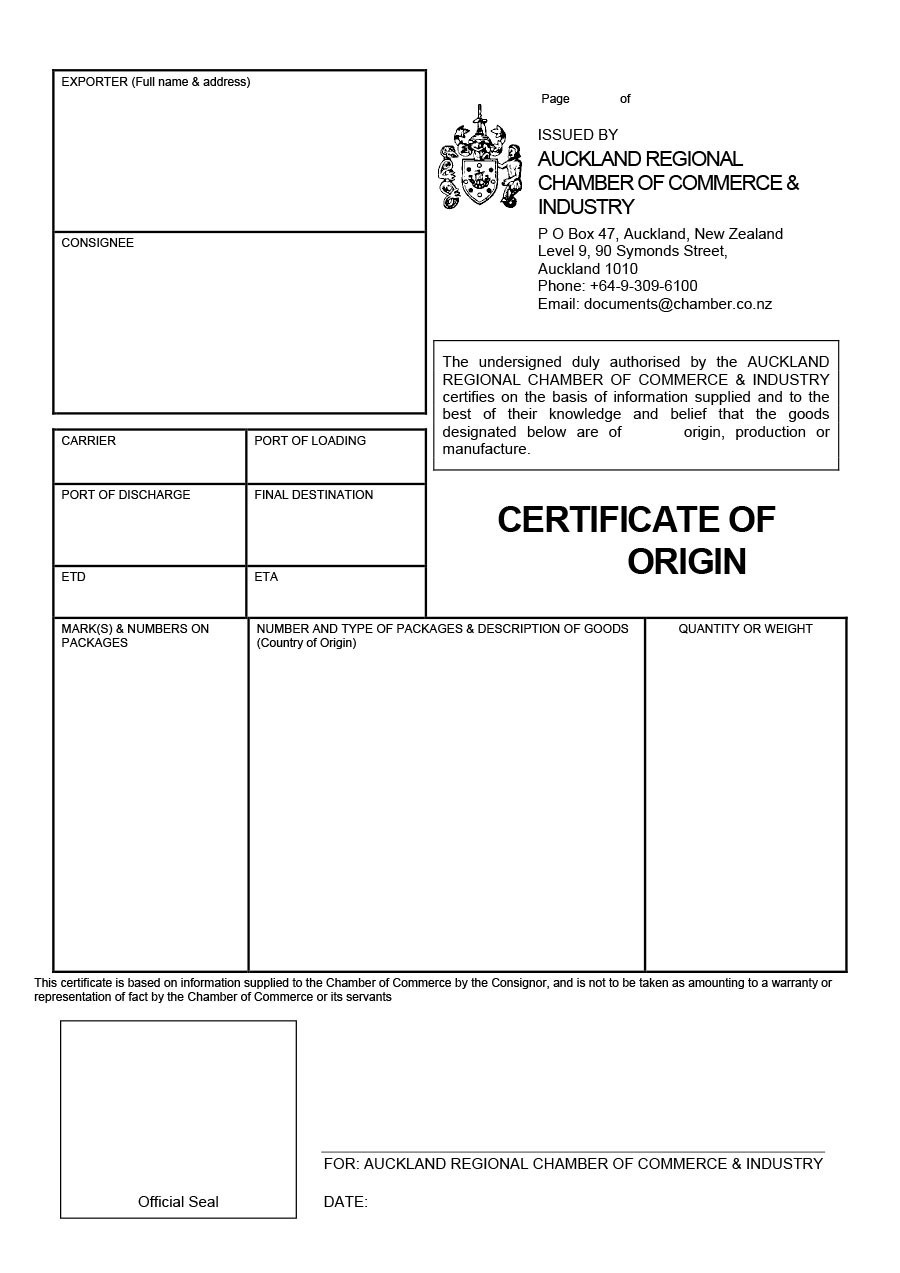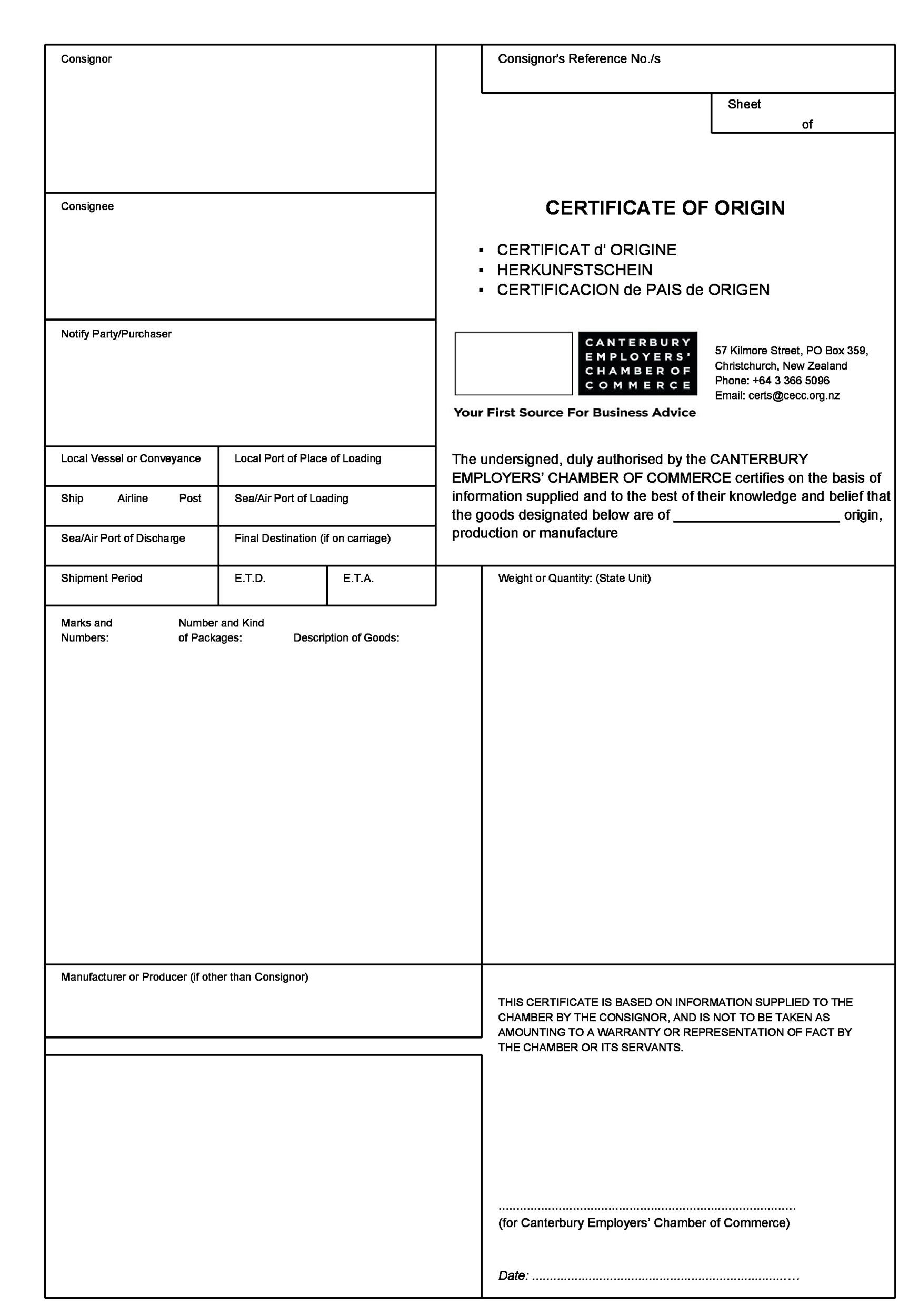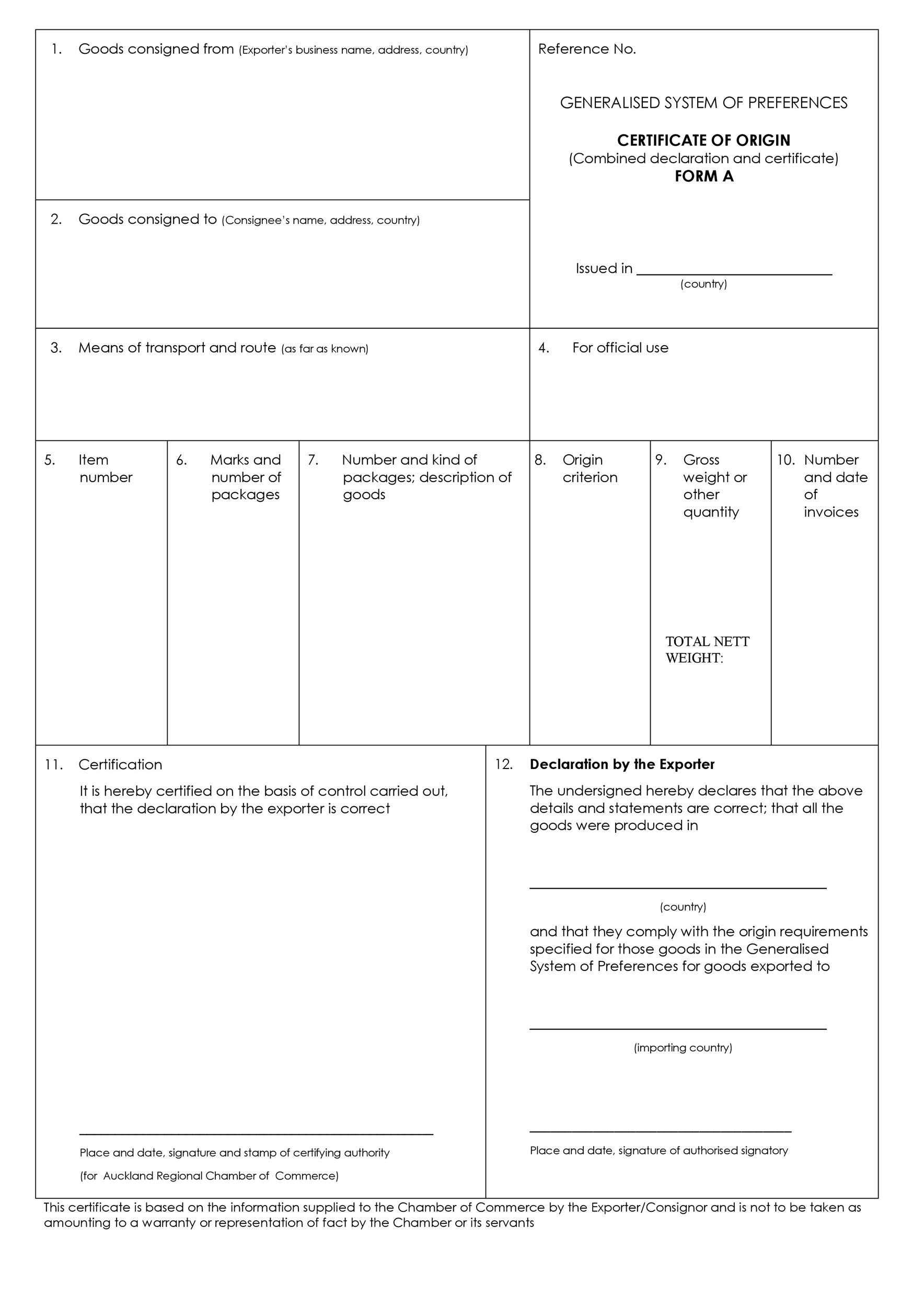A certificate of origin template is a type of document which contains a declaration of which country a good or commodity got manufactured. A certificate of origin form contains information about the products, the country of export, and their destination. This document is a requirement by several treaty agreements to determine the eligibility for import and more.
Table of Contents
- 1 Certificate Of Origin Templates
- 2 When do you need a certificate of origin?
- 3 Certificate Of Origin Forms
- 4 All about certificate of origin USA
- 5 Types of a certificate of origin
- 6 The importance of a certificate of origin
- 7 Certificate Of Origins USA
- 8 Applying for a certificate of origin
- 9 Obtaining a certificate of origin
Certificate Of Origin Templates
When do you need a certificate of origin?
Customs officials require a certificate of origin template as a separate document from a packing list or a commercial invoice. In certain countries, they also expect the certificate of origin form to have a signature from the exporter and that the document is first notarized.
After that, the document must have a stamp and signature by the chamber of commerce. There are also some countries where customs officials may also request proof of review from the chamber of commerce. So, if you’re in the business of import and export, you must have your own blank certificate of origin template for your business.
Certificate Of Origin Forms
All about certificate of origin USA
If you own a business which deals with importing and exporting goods in America, then you should know all about certificate of origin USA. Some countries require you to have a certificate of origin template for specific commodities. The purpose of this document is to validate the country of origin of the shipped items.
You can create your own blank certificate of origin and use this as needed. If any treaty agreements exist, you need this document. You also need this because of varying duty rates as well as preferential duty treatment which depends on the origin of the shipment.
The certificate of origin serves as a verification of where the products came from. The nature of the products and the destination determine whether you need to prepare a certificate of origin USA or not. Some countries are very strict, especially in terms of limiting the allowable quantity of imported goods.
In the US, the certificate of origin form requires an authorized signature of the secretary of the local Chamber of Commerce along with the organization’s seal. Make use of the NAFTA certificate of organization template for Mexican or Canadian destinations if the goods are of a North American origin.
Make sure that the amounts and descriptions written on your document must match those written on your invoice. Generally, you require this kind of certificate when the goods originated from the US and the products and destinations are:
- Albania: If the goods are any kinds of commercial medicines, medical equipment, drugs, and food.
- Argentina: If the goods are any kind of textiles no matter what their value is.
- Austria: If the goods are any kind of commercial textiles unless they are textile samples with no commercial value.
- Belgium: If the goods are any kind of textile products originating from non-EU countries unless they are textile samples with no commercial value.
- Bolivia: All kinds of non-documents with a value of over $3,000.
- Canary Islands: All non-document goods.
- Denmark: Any textile shipments which have a value of over $110 and those which come from non-EU countries.
- Finland: For non-EU countries, all textile samples and commercial textiles with a value of over $54.
- France: All textile and clothing shipments originating from non-EU countries if they have a value of over $980.
- Germany: All commercial textile shipments as well as textile samples with a customs value of over $230.
- Greece: All textile and commercial shoe shipments originating from non-EU countries.
- Ireland: All textile shipments with a value of over $234.
- Italy: All textile shipments and online purchases from private citizens.
- Japan: Silk products more than 300-square-meters in size.
- Kuwait: All non-documents with a value of more than $1500.
- Netherlands: All textile shipments with a value of over $319.
- Spain: All shipments which have eligibility for duty-free treatment because of any trade agreements which exist as well as all kinds of textile shipments.
- UK: Any textile shipments with a value of over $25.
Types of a certificate of origin
There’s no such thing as a standard certificate of origin template. But the things all templates have in common is that they must have basic details regarding the shipped products, a tariff code, the importer and exporter, and the country of origin. It’s the responsibility of the exporter to document this information.
Then, he must get the certificate of origin form notarized and submit it along with the shipment. The more specific detail requirements of such a document depend on the types of exported goods and their destination. There are two types of certificates of origin you can create:
- Non-preferential: These are also known as “ordinary certificates of origin” and they indicate that the shipped goods don’t qualify for tariff-free or reduced tariff treatments under any trade agreements.
- Preferential: These documents contain a declaration that the shipped goods qualify for tariff treatments. To learn more about this, you can refer to the Generalized System of Preference or GSP of each country.
The importance of a certificate of origin
A certificate of origin is a document which indicates the country of origin of shipped products meaning where these products got produced, manufactured, grown or processed. This document is essential on any export or import shipments for these reasons:
- It provides entitlement to business owners to preferential duty programs through trade agreements.
- It helps business owners determine the rate of duty. For instance, a manufacturer completes this document and gives a copy to the importer at the same time he makes the declaration.
- It helps business owners determine whether they can legally import or export certain goods.
- It helps set control management of exports and imports.
- It’s useful for statistical reporting.
- It helps fulfill the proper requirements for product marketing.
- It helps differentiate the product from other similar products.
- It helps make the customs processes go smoothly.
You may need a country of origin document to comply with all of the terms and conditions of the foreign country you’re importing or exporting items to. Typically, you would attach this document to an invoice which contains the same information.
Before shipping any goods, it’s important for you to do research on or communicate with a company that deals with international transportation. In doing this, you can determine whether or not you need to fill a blank certificate of origin with all of the required information as part of their requirements.
You can either submit the form along with your invoice or submit it online. Again, this depends on the transport company you choose to work with. Make sure to check the rules of the country you plan to deal with as well to ensure that you don’t run into any issues.
Certificate Of Origins USA
Applying for a certificate of origin
A lot of people find it easier to apply for this type of certificate online. For this process, you need to provide specific information including:
- the details about the producer or manufacturer
- the details about the consignee
- the transport details
- the details about the goods you plan to import or export
When applying for the certificate online, you have the option to choose from a list of producers, consignees, and goods which come pre-loaded or you can manually add all of these details during the application process.
Any goods which you haven’t previously included on an approved certificate must undergo checking to make sure that they meet all of the relevant criteria. If there is an issue with your application, you will receive an email containing an explanation about the issue. After addressing the issues, you can re-submit your application.
If your application doesn’t have any problems, then it’s most likely to get approved. Once again, you’ll receive an email notifying you of the approval along with a PDF file of your certificate.
In cases where your original certificate gets stolen, lost or damaged, you need to have an authorized signatory declare that:
- To the best of their belief and knowledge, the original copy of your certificate has, indeed, been either stolen, lost or damage.
In the case of the latter, you must attach the original (damaged) copy of the certificate along with the declaration. Also, provide a detailed explanation of what happened to your document.
Obtaining a certificate of origin
A certificate of origin is an essential document in import and export processes. You need this document for when you plan to export goods to certain countries, especially when it’s one of the requirements of the process. The document contains relevant information about the goods you’re sending for the benefit of customs.
Although the process of obtaining this certificate is pretty straightforward, there are specific procedures which you must follow:
- Attach an Exporters Information Form Update if necessary, along with a list of authorized signatories to affix their signatures on your certificates on behalf of your business.
- Provide evidence of origin before stamping on the document.
- Provide a copy of all the stamped documents for the records of the Chamber of Commerce.
- Before you submit the document for authentication, sign all of the export documents right underneath the statement of declaration.
- Never write the certificate by hand. You must type, check, and print it out.



